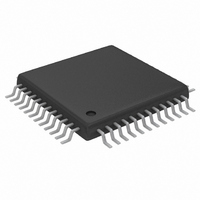MAX1197ECM+TD Maxim Integrated Products, MAX1197ECM+TD Datasheet - Page 19

MAX1197ECM+TD
Manufacturer Part Number
MAX1197ECM+TD
Description
IC ADC 8BIT 60MSPS DL 48-TQFP
Manufacturer
Maxim Integrated Products
Datasheet
1.MAX1197ECMD.pdf
(22 pages)
Specifications of MAX1197ECM+TD
Number Of Bits
8
Sampling Rate (per Second)
60M
Data Interface
Parallel
Number Of Converters
2
Power Dissipation (max)
150mW
Voltage Supply Source
Single Supply
Operating Temperature
-40°C ~ 85°C
Mounting Type
Surface Mount
Package / Case
48-TQFP Exposed Pad, 48-eTQFP, 48-HTQFP, 48-VQFP
Lead Free Status / RoHS Status
Lead free / RoHS Compliant
Figure 11. T/H Aperture Timing
inductance. Bypass V
two parallel 0.1µF ceramic capacitors and a 2.2µF
bipolar capacitor to GND. Follow the same rules to
bypass the digital supply (OV
boards with separated ground and power planes pro-
duce the highest level of signal integrity. Consider the
use of a split ground plane arranged to match the
physical location of the analog ground (GND) and the
digital output driver ground (OGND) on the ADC’s
package. The two ground planes should be joined at a
single point so the noisy digital ground currents do not
interfere with the analog ground plane. The ideal loca-
tion for this connection can be determined experimen-
tally at a point along the gap between the two ground
planes, which produces optimum results. Make this
connection with a low-value, surface-mount resistor (1Ω
to 5Ω), a ferrite bead, or a direct short.
Alternatively, all ground pins could share the same
ground plane, if the ground plane is sufficiently isolated
Figure 10. Typical QAM Application Using the MAX1197
Dual, 8-Bit, 60Msps, 3V, Low-Power ADC with
DATA (T/H)
SAMPLED
ANALOG
INPUT
CLK
T/H
t
AD
TRACK
______________________________________________________________________________________
Internal Reference and Parallel Outputs
DD
, REFP, REFN, and COM with
t
HOLD
AJ
DD
) to OGND. Multilayer
DOWNCONVERTER
TRACK
MAX2451
from any noisy, digital systems ground plane (e.g.,
downstream output buffer or DSP ground plane). Route
high-speed digital signal traces away from the sensitive
analog traces of either channel. Make sure to isolate
the analog input lines to each respective converter to
minimize channel-to-channel crosstalk. Keep all signal
lines short and free of 90° turns.
Integral nonlinearity (INL) is the deviation of the values
on an actual transfer function from a straight line. This
straight line can be either a best-straight-line fit or a line
drawn between the endpoints of the transfer function,
once offset and gain errors have been nullified. The
static linearity parameters for the MAX1197 are mea-
sured using the best-straight-line-fit method.
Differential nonlinearity (DNL) is the difference between
an actual step width and the ideal value of 1LSB. A
DNL error specification of less than 1LSB guarantees
no missing codes and a monotonic transfer function.
Figure 11 depicts the aperture jitter (t
sample-to-sample variation in the aperture delay.
Aperture delay (t
rising edge of the sampling clock and the instant when
an actual sample is taken (Figure 11).
÷ 8
Dynamic Parameter Definitions
0°
Static Parameter Definitions
90°
AD
) is the time defined between the
Differential Nonlinearity
INA+
INA-
INB+
INB-
MAX1197
Integral Nonlinearity
Aperture Delay
Aperture Jitter
AJ
), which is the
PROCESSING
POST-
DSP
19











